
When it comes to food, habit is often the enemy of good taste, and there is no better example of this than seafood. Regardless of how healthful, delicious, and readily available it is, many Americans rarely prepare seafood at home. There has been a tendency to regard it as a treat—to enjoy seafood on special occasions, to eat it out at a restaurant like Chanterelle rather than enjoy it at home. This really is a shame, since in the past few years chefs and home cooks alike have gained access to an increasing bounty of wonderful seafood. Thus there’s no reason to miss out on monkfish roasted to perfection, elegant Fresh Salmon Croquettes (page 218) with rémoulade, or a vibrant Provençal Fish Stew (page 232) fragrant with saffron and herbs.
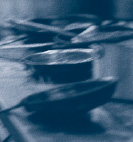
When you know how to prepare a good brown butter sauce, sautéed fish fillets rise above the ordinary into a more refined and elegant realm. Any fish would be honored to join it on a plate. The trick to making this sauce is allowing the butter to reach the perfect degree of golden brownness as it swirls in the pan over high heat. The wonderful, nutlike flavor and aroma that emerge at this precise point define the sauce—but be careful, since only a second or two separates brown from burnt butter. Have the lemon juice, capers, salt, pepper, and parsley ready and waiting so they can be added swiftly at just the right moment. The lemon juice halts the browning process, allowing a few seconds for you to finish the sauce.
This recipe, which is also very good made with halibut or swordfish, can easily be doubled or even tripled. Once you’ve made brown butter a few times, experiment with adding other flavorful ingredients like pecans or almonds, fresh tarragon or chives, shallots or garlic, depending on the type of fish. SERVES 2
2 salmon fillets (7 to 8 ounces each), skinned and boned
Coarse (kosher) salt and freshly ground black pepper, to taste
2 tablespoons canola or other vegetable oil
2 tablespoons unsalted butter, cut into 4 pieces
Juice of ½ lemon
1 teaspoon small (nonpareil) capers
1 teaspoon chopped fresh flat-leaf parsley leaves
1. Rinse the salmon, then pat dry. If the fish still has a few bones, remove them with tweezers or your fingers. Sprinkle the fish all over with salt and pepper.
2. Heat a large, nonstick skillet over medium-high to high heat. Add the oil and, when it’s almost smoking, add the salmon and sauté until lightly browned on both sides, about 3 minutes per side. How long you need to cook the fish depends on how thick it is and how done you like it (see box). When it’s cooked to the desired doneness, transfer the fish carefully to individual serving plates and cover lightly with aluminum foil to keep warm while you prepare the sauce.
3. Wipe out the skillet with paper towels. Place it back over medium-high to high heat and add the butter. Let the butter melt, swirling it as it foams up, then subsides. When it reaches a dark, nutty brown, a matter of mere seconds (take care that it doesn’t burn), immediately add the lemon juice, capers, salt, and pepper. Cook, stirring, for a few seconds more, then add the parsley. When the parsley sizzles, remove the skillet from the heat, pour the sauce over the fish, and serve immediately.
testing fish for doneness
Fish is fragile and cooks quite quickly, often more quickly than you expect. How long it should be cooked depends on the density, thickness, and shape of the fillet or steak. It’s impossible to give precise cooking times, especially for sautéing; however, the flesh is translucent before it is heated, then becomes opaque as it cooks. Use as high a heat as you dare to sear the surface of the fish so it will be lightly browned outside, moist and flavorful inside. Test for doneness by gently poking a knife or fork into the thickest part of the fish. The more resistance you feel, the less cooked it is. When checking for doneness, remember that fish continues to cook after it leaves the heat, so removing it from the pan slightly before it seems done lessens the risk of overcooking.
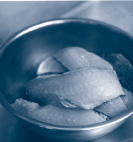
This real front-of-the-house dish is easy to make and terrific to serve as an unusual luncheon dish or as a first course at dinner. Because it’s prepared in advance, there’s no last-minute work involved. The wasabi sauce packs a powerful punch, so be sure you tell your guests to use it sparingly. Serve the salmon with Ginger Pickled Vegetables (page 343), a tossed green salad, or potato salad. SERVES 8 AS A FIRST COURSE OR LIGHT LUNCH
FOR THE PICKLED SALMON:
1 piece (1½ pounds) best-quality center-cut salmon fillet, skin removed
Pickling Brine (recipe follows)
FOR THE WASABI SAUCE:
¼ cup wasabi powder
¼ cup rice vinegar
¼ cup water
1 tablespoon Dijon mustard
¼ cup canola or other vegetable oil
½ teaspoon coarse (kosher) salt
Finely snipped chives, for garnish
1. Run your fingers lightly over the salmon, feeling for bones. Remove any you find with tweezers or your fingers. Place the salmon in a large glass or ceramic bowl and pour the pickling brine through a colander into the bowl. Fold up a clean kitchen towel, soak it in the brine, then place it on the salmon to keep it submerged. Or place a small plate on the salmon to hold it under the brine. Cover the bowl with plastic wrap and refrigerate for at least 48 hours and as long as 3 days. The longer it stays in the brine, the more “cooked” its texture will be.
2. While the salmon is pickling, prepare the wasabi sauce. Place the wasabi powder, vinegar, water, and mustard in a food processor and pulse a few times to combine. With the machine running, slowly pour in the oil through the feed tube and process to form a slightly thickened sauce. Add the salt, pulse a few times, then transfer the sauce to a storage container. This sauce will keep for 1 month, covered, in the refrigerator.
3. When you’re ready to serve, remove the salmon from the brine and pat it dry with paper towels. Using a sharp knife, slice the salmon crosswise into ⅛-inch-thick slices.
4. To serve, fan out several slices of the salmon on a plate, drizzle with the wasabi sauce, and garnish with the snipped chives.
Redolent with ginger, this brine can be used to pickle vegetables (page 343) as well as salmon. The brine takes almost no time to prepare and the flavor it gives to vegetables and fish is memorable. MAKES ABOUT 8 CUPS
1¾ pounds fresh ginger, scrubbed and thinly sliced crosswise
1 pound (2 cups) sugar
4 cups cider vinegar
4 cups water
1 clove garlic, peeled and crushed
2 tablespoons coarse (kosher) salt
1 tablespoon black peppercorns
Place all the ingredients in a large, nonreactive saucepan and bring to a boil over high heat. Boil for 5 minutes, then remove the pan from the heat and cool to room temperature. Transfer the brine to a storage container, cover, and refrigerate overnight.

Serve this richly sauced salmon dish the next time you have something very special to celebrate. In French cooking a thick, velvety butter sauce similar to this one is known as beurre blanc (white butter). Made from a reduction of vinegar, wine, or lemon juice, and chopped shallots into which a luxurious amount of butter is whisked, classic beurre blanc has a natural affinity for seafoods of all kinds, particularly salmon. Butter sauces can be daunting for those who haven’t tried their hand at one before, but you’ll find this nontraditional variation straightforward and delicious. It calls for a little cream, which acts as a stabilizer and helps prevent the mixture from separating if it gets too hot. There’ll be enough warm sauce for 4 pieces of salmon; I usually allow at least ¼ cup of sauce per serving, but the recipe can successfully be doubled or tripled if you wish. SERVES 4
1 cup fresh lime juice
½ cup dry white wine
¼ cup heavy (or whipping) cream
1 cup (2 sticks) unsalted butter, cut into small pieces, chilled
Coarse (kosher) salt and freshly ground black pepper, to taste
4 salmon fillets with skin (6 to 8 ounces each)
3 tablespoons canola or other vegetable oil
1. Combine the lime juice and wine in a small, heavy, nonreactive saucepan. Bring to a boil over high heat and cook, uncovered, until the liquid is reduced to about ¼ cup, about 10 minutes. Be very careful, because the reduction will begin to burn in no time if it isn’t watched.
2. Stir in the cream and continue reducing at a boil until the cream thickens but does not color, about 2 minutes more. Turn the heat down to very low, then vigorously whisk in the butter, a few bits at a time, waiting until the previous bits are completely incorporated before adding the next. While you’re adding the butter, keep checking the temperature of the sauce. Move it on and off the heat to maintain a warm—not too hot, not too cool—temperature. If you notice the sauce getting too thick, the temperature is too low. If the sauce gets too hot, it will begin to look greasy. When all the butter has been incorporated, remove the pan from the heat. Season the sauce with salt and pepper and cover to keep warm.
3. Rinse the salmon, making sure the skin is free of scales, then pat dry. If the fish still has a few bones, remove them with tweezers or your fingers. Using a very sharp knife, score the skin with a few shallow cuts in a cross-hatch pattern.
4. Heat the oil in a large, nonstick skillet over high heat. Generously salt both sides of the salmon, then place it skin-side down in the skillet and sauté until the skin is golden brown and crispy, about 4 minutes. Adjust the heat as necessary so the skin gets crisp without overcooking the fish. Resist the urge to fiddle with the salmon too soon, or you’ll tear the skin. When the skin is the right color and texture, turn the fish over and sauté on the second side for 3 to 5 minutes, depending on how done you like your fish. I prefer it rare, but this is not to everyone’s taste; at 5 minutes it will be medium.
5. Ladle about ¼ cup sauce onto each serving plate and top with a piece of the fish, skin-side up. Serve immediately.
saving a separated butter sauce
If a butter sauce separates after it’s made because it’s being held in a pan that has become too hot, the best way to repair it is by skimming off and discarding the melted butter that has risen to the top. Then bring the remaining sauce just to a simmer over medium heat and vigorously whisk in additional cold butter, a little bit at a time, until the sauce regains the correct consistency. Taste and adjust the seasoning.
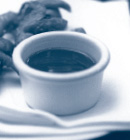
In the 1950s and 1960s nearly everyone’s mother fried up croquettes. Made with canned fish, the salmon croquettes in my mom’s repertoire were never one of my favorite dishes. In fact, I shudder even now at the memory of them. However, I’m a firm believer in wasting nothing, and in a restaurant kitchen that means devising recipes that use up the valuable trimmings left when preparing attractive portions for our customers. Salmon, for example. The trimmings are just too generous and rich with fish to throw out. Trimmings are a natural to use in croquettes, so my challenge was to create a recipe for croquettes that I really like … and these croquettes I really like. They are worthy of the center-cut portion of a salmon fillet, but if the fishmonger will sell you tail ends for less, by all means use them. In fact, these burger-shaped croquettes can also be made with leftover cooked salmon if you have some.
Serve salmon croquettes for lunch or a casual supper, with or without a bun, accompanied by a dollop of Rémoulade (page 366) or Kitchen Cupboard Tartar Sauce (page 367) and a side of Creamed Spinach (page 340) or Slightly Southern Potato Salad (page 333). SERVES 6
2 pounds salmon fillets, skinned and cut into 2-inch pieces
1 cup fine dry bread crumbs see page 279
½ cup heavy (or whipping) cream
¼ cup finely chopped shallots
1 clove garlic, minced
2 tablespoons mixed chopped fresh herbs, such as flat-leaf parsley, dill, and chervil leaves
2 large eggs
2 tablespoons fresh lemon juice
¼ teaspoon Tabasco sauce
Coarse (kosher) salt and freshly ground black pepper, to taste
All-purpose flour, for coating
½ cup canola or other vegetable oil
2 tablespoons unsalted butter
1. Put the salmon through the medium blade of a meat grinder into a large bowl. Lacking a meat grinder, chop the salmon by hand or place it in a food processor and pulse briefly until chopped medium fine, then transfer it to a bowl. Be careful not to chop the fish too fine or the croquettes will be dry.
2. To the salmon add the bread crumbs, cream, shallots, garlic, herbs, mustard, eggs, lemon juice, Tabasco, salt, and pepper. Using your hands or a wooden spoon, mix thoroughly. Form the mixture into six burgerlike patties, each about ¾ inch thick. Spread about ½ cup flour on a plate and dip the patties, one at a time, in it to coat on both sides, shaking off any excess.
3. Heat the oil in a large, heavy skillet over medium heat; it should be hot enough so a sprinkle of flour sizzles on contact. Add the butter to the hot oil and, as soon as it has melted, add the salmon croquettes and fry until cooked through and golden brown on both sides, about 5 minutes per side.
4. Using a slotted spatula, transfer the croquettes to paper towels to drain, then serve immediately.
real people
Restaurant kitchens are organized into “stations,” each station geared to perform a specific task. Although the details of how the stations are organized varies from one restaurant to the next, it’s expected that each person working a station knows precisely what to do and when to do it. As ingredients are washed, trimmed, peeled, chopped, cooked, or carved, each person keeps in mind which of the ingredients that go into the dishes being prepared will be usable for us at our staff meal. That lovely poached salmon? It’s for the “real people”—the trimmings from it become our salmon croquettes!
When it comes to varying a cook’s repertoire, few flavor-enhancing techniques are as foolproof as marination. These easy marinades take only a couple of minutes to prepare, and each imparts subtle, intriguing tastes to mild, meaty fish. Here I use tuna steaks, but red snapper or monkfish would also be good choices. Marinate overnight, if possible. If not, even an hour’s worth will make a flavorful difference. Soba Salad (page 337) is a good side-dish choice for either variation. SERVES 4
Honey Soy Marinade or Ginger Wasabi Marinade (recipes follow)
4 tuna steaks (1 inch thick; 7 to 8 ounces each)
1. Pour the marinade of your choice into a sturdy plastic bag large enough to hold the tuna steaks flat. Add the tuna to the bag, gently shaking it to make sure that each piece is coated with marinade, then express the air from the bag and seal tightly with a twist-tie. Place the bag on a large plate, making sure all the pieces are lying flat so as not to bruise them. Refrigerate for at least 1 hour and up to 24 hours. (This technique ensures that the tuna is evenly immersed in the marinade, eliminating the need to turn the fish occasionally.)
2. When you’re ready to cook the tuna, preheat a grill or large cast-iron skillet to very hot (see Note).
3. Remove the tuna from the marinade and pat dry. Grill or pan-fry, searing the outside and keeping the interior rosy, about 2 minutes per side. Serve immediately.
Note: Most home broilers cannot achieve a high-enough temperature to sear tuna correctly, so I prefer grilling or pan-frying in a very hot cast-iron skillet. Whichever method you use, be careful not to overcook the fish or it will be dry.

The fresh lime juice and Chinese dried orange peel form the basic character of this marinade. The honey and sugar add a nice hint of sweetness and also help caramelize and brown the exterior of the fish a bit as it cooks. MAKES ABOUT 2¼ CUPS
2 cups good-quality soy sauce, such as Kikkoman
Juice of 2 limes
2 tablespoons honey
1 teaspoon grated fresh ginger
1 teaspoon hot red pepper flakes
1 clove garlic, minced
3 pieces Chinese dried orange peel (see page 51), softened, or fresh orange zest (outer skin only, no white pith)
Combine all the ingredients in a small, nonreactive saucepan and bring to just a simmer over medium heat. Remove the sauce immediately from the heat and let it cool completely before using.
This marinade, is lighter than the Honey Soy version. The mirin—a sweetened Japanese rice wine used in cooking—smooths the bite of the wasabi and ginger. MAKES ABOUT 2½ CUPS
2 cups good-quality soy sauce, such as Kikkoman
½ cup mirin
1 tablespoon sugar
½ teaspoon grated fresh ginger
½ teaspoon wasabi powder
Combine all the ingredients in a small bowl and stir until the sugar is dissolved. The marinade is ready to use.

Lotte, as it is called in France and quite often on restaurant menus here, is generally known in the United States as monkfish. In the past decade this versatile fish has enjoyed a newfound popularity, which it richly deserves. It’s a truly delicious, sweet, firm-textured fish that easily holds its own in both refined and robust preparations. Here it’s paired with slowly cooked leeks that become a meltingly sweet and tender foil for the tart butter sauce. Serve this rich dish with green beans and some roast new potatoes. SERVES 4
2 bunches large leeks (6 to 8 leeks total)
1 cup (2 sticks) unsalted butter, chilled
¼ cup minced shallots
1¾ cups dry white wine
½ cup white wine vinegar
3 tablespoons heavy (or whipping) cream
1 teaspoon chopped fresh tarragon leaves
Coarse (kosher) salt and freshly ground black pepper, to taste
3 cups water
4 monkfish fillets (about 2 inches in diameter; 7 to 8 ounces each), trimmed of membrane and cut crosswise into ½-inch diagonal slices
2 teaspoons chopped fresh flat-leaf parsley leaves
1. Trim the root ends of the leeks and discard. Cut off the green tops, leaving a couple of inches attached to the white. Save the tops for stock or soup. Slice the leeks lengthwise and then crosswise into 1-inch segments. Thoroughly rinse the leeks in a colander under cold running water or, if they’re particularly sandy, soak them in a bowl of cold water for 30 minutes before rinsing and draining thoroughly.
2. Melt 2 tablespoons of the butter in a medium-size, heavy, nonreactive pot over low heat. Add the leeks, cover, and cook them very slowly, uncovering occasionally to stir, until they’re very soft, almost melted, about 1 hour.
3. While the leeks are cooking, prepare the sauce. Cut the remaining butter into small pieces and keep refrigerated until needed. Combine the shallots, ¾ cup of the wine, and the vinegar in a small, heavy, nonreactive saucepan and bring to a boil over high heat, then reduce the heat to maintain a steady simmer. Cook, uncovered, until the liquid is reduced to about 1 tablespoon (it will appear almost dry), about 15 minutes; be very careful not to let it burn. Add the cream and cook, uncovered, until it’s reduced by half and thickens considerably, about 2 minutes. Remove the butter from the refrigerator and whisk it, bit by bit, into the reduction, adding the next bit as the previous one has been emulsified into the sauce. Keep checking the temperature of the sauce. It should stay very warm, almost but not quite hot; nor should it get too cool. To accomplish this, move the pan on and off the heat as necessary. Stir in the tarragon, season with salt and pepper, and keep warm (see Note).
4. About 15 minutes before the leeks are done, combine the water, remaining 1 cup wine, and a large pinch of salt in a large, deep, nonreactive skillet and bring to a boil over high heat, then reduce the heat to maintain a steady simmer. Add the monkfish slices to the simmering liquid and poach until just cooked through, 2 to 3 minutes (see page 213). Using a slotted spoon, carefully transfer the fish to a clean kitchen towel to drain.
5. Remove the leeks from the heat and season with salt and pepper, then divide among four serving plates. Spoon the sauce over the portions of leeks, dividing evenly. Sprinkle with the parsley, then top with the sliced fish. Serve immediately.
Note: A butter sauce is meant to be eaten warm, not hot. Kept covered, it should retain enough heat to last until you’re ready to serve the fish.
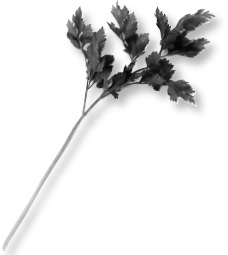
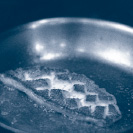
The tail section of monkfish is the edible part, so that portion, and only that, is what you’ll find in stores. It may be sectioned into fillets, which are cut from either side of the backbone or center cartilage, or it may be the whole tail (ranging from 6 or 7 ounces to almost 10 pounds) with the center cartilage intact. In France a large tail, roasted to perfection like a leg of lamb, is called gigot de lotte. Because monkfish is so meaty, firm, and juicy, it’s ideally suited to roasting, as you will soon taste for yourself. Although this recipe is light enough to be served year-round, I think of it as a fall or winter dish because of the earthy flavors of the roast shallots and garlic. SERVES 4
16 medium shallots
1 head garlic
¼ cup olive oil
Coarse (kosher) salt and freshly ground black pepper, to taste
4 monkfish fillets (about 2 inches in diameter; 7 to 8 ounces each), trimmed of membrane
1 large sprig fresh thyme
½ cup dry white wine
2 tablespoons unsalted butter
1. Preheat the oven to 325°F.
2. Trim the tip of the root end of each shallot, leaving just enough to hold the shallot together. Peel off the outer layers of skin, leaving the last layer or two. Separate the cloves of garlic and peel them.
3. Place the shallots and garlic in a 16 × 9-inch flameproof roasting pan and toss with 2 tablespoons of the oil and the salt and pepper, then roast until soft, about 45 minutes. Stir the shallots and garlic every so often, and if they seem to be browning too quickly, reduce the oven temperature to 300°F. When the shallots and garlic are soft, remove the pan from the oven and increase the temperature to 425°F.
4. Heat the remaining 2 tablespoons oil in a large, heavy skillet over high heat. Add the monkfish fillets, sprinkle with salt and pepper, and brown quickly on all sides, about 2 minutes per side. Remove the skillet from the heat and transfer the fillets carefully to the roasting pan with the shallots and garlic. Add the thyme, then roast the monkfish until just cooked through, about 10 minutes. Remove the roasting pan from the oven and carefully transfer the fish to a cutting board. Let it rest while you finish the dish.
5. Place the roasting pan over high heat and add the wine. Bring it to a boil and cook until reduced by half, 3 minutes. Add the butter and continue to cook, whisking until the butter is incorporated. Remove the pan from the heat and discard the thyme sprig. Season the sauce with salt and pepper.
6. To serve, divide the shallots and garlic, along with some of the sauce, among four serving plates. Cut each monkfish fillet into diagonal ½-inch slices and arrange on the plates, over the sauce and among the shallots and garlic. Serve immediately.
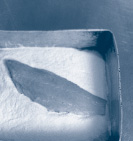
Here’s a simplified version of one of the dishes that Karen and I most enjoy ordering at Thai restaurants. The gingery sauce is typically served over a whole fish that has been slashed to the bone with a sharp knife, then fried in oil until it’s so extravagantly crisp you can practically eat the crunchy bones. Amazingly, however, the flesh remains wonderfully moist. For our staff meal, I usually serve the sauce with sautéed fish fillets, which are easier and faster to prepare. As a special treat, try the sauce with soft-shell crabs, since their crispy exterior and soft interior are similar in texture to those of the whole fried fish. SERVES 4
8 dried shiitake mushrooms
2 cups Chicken Stock (page 39) or canned low-sodium chicken broth
¼ cup sugar
⅓ cup rice vinegar or cider vinegar
2½ tablespoons oyster sauce
2 tablespoons good-quality soy sauce, such as Kikkoman
1 tablespoon fresh lime juice
1 tablespoon Thai fish sauce (nam pla)
1 tablespoon cornstarch
2 tablespoons cold water
1 teaspoon hot red pepper flakes
1½ tablespoons grated fresh ginger
1 medium onion, sliced lengthwise
1 small red bell pepper, stemmed, seeded, and cut into thin strips
3 scallions, white and green parts, trimmed and cut into ¼-inch lengths
1 cup all-purpose flour, for coating the fish
4 mild white fish fillets (about 8 ounces each), such as red snapper, flounder, or bass
2 tablespoons canola or other vegetable oil
Coarse (kosher) salt, to taste
1. Place the shiitake mushrooms in a small bowl with very hot water to cover. Let soak for 30 minutes to soften. Lift the mushrooms from the soaking liquid, leaving the grit behind. Trim away any stems and slice the caps. Strain the soaking liquid through a strainer lined with several layers of cheesecloth and add to the saucepan in step 2.
2. Combine the chicken stock, shiitakes, sugar, vinegar, oyster sauce, soy sauce, lime juice, and fish sauce in a small, nonreactive saucepan and bring to a boil over high heat. Reduce the heat to low and simmer, uncovered, until the flavors have blended, about 20 minutes.
3. Whisk the cornstarch with the water to blend. When it’s smooth, whisk it into the sauce, whisking constantly until the sauce thickens, 1 minute. Add the pepper flakes and ginger and simmer for 1 minute more. Add the onion, bell pepper, and scallions and cook just until heated through, another 1 to 2 minutes; the vegetables should still be very crisp. Remove from the heat and taste for seasoning. Keep warm while you prepare the fish.
4. Spread the flour on a plate and dip the fish fillets, one at a time, in it to coat on both sides, shaking off any excess.
5. Heat the oil in a large skillet over medium-high heat. Sprinkle the fish fillets lightly with salt, then add them to the skillet. Sauté until lightly browned and cooked through, 2 to 3 minutes per side.
6. Transfer the fillets to a platter or individual plates and spoon the sauce over them to serve.
fresh ginger
Pungent, peppery, and slightly sweet, ginger is one of the most extensively used flavorings in Asian cooking. There are two types of ginger, mature and young. Mature ginger is easy to find year-round in almost all supermarkets. Select firm, plump knobs with taut, unwrinkled, pale tan skin that’s shiny. Avoid any that are soft or wrinkled, and bear in mind that the older the ginger, the more fibrous it will be.
Young ginger, also called stem or spring ginger, is a special treat available only twice a year, in January and February and again in July and August. Look for it in Asian markets. In contrast to mature ginger, harvested at around 10 months, tender young ginger is only 3 to 4 months old and is more perishable. It’s juicy and pungent, though not as spicy and sharply flavored as mature ginger, so you’ll need to use more of it in a recipe. Young ginger is lovely looking, with pale yellow skin that is paper thin to the point of translucency and rosy pink tips at the end of the knobs. No peeling is necessary.
To store ginger, wrap the knobs in paper towels (to absorb mold-inducing moisture), place in a loosely closed plastic bag, and refrigerate for up to 3 weeks in the vegetable drawer.

It may seem odd, but I have a soft spot for the style of Chinese cooking that has become the hallmark of take-out restaurants. Although there’s no question that it’s an Americanized mutation of one of the world’s great cuisines, I find the flavors and textures of many of the dishes appealing. It’s inauthentic in the same way that take-out pizza isn’t genuinely Italian, even though it can be satisfying and good to eat.
This recipe was inspired by the sweet-pungent thick sauce that characterizes a wide range of Chinese take-out dishes. It’s very good with crispy fish fillets, as the recipe specifies, or served with scallops or chicken tenderloins that have been coated with flour or cornstarch and pan-fried. Although I generally use canola oil for frying, I think peanut oil works best for this dish. SERVES 6
2 tablespoons vegetable oil, preferably peanut, plus additional for frying
1 small clove garlic
¾ teaspoon grated fresh ginger
2 cups Chicken Stock (page 39) or canned low-sodium chicken broth
2 tablespoons white wine or rice vinegar
2 tablespoons ketchup
4 teaspoons sugar
1 tablespoon good-quality soy sauce, such as Kikkoman
¾ teaspoon Chinese chili paste, or other hot sauce
2 teaspoons cornstarch
3 tablespoons cold water
1 cup all-purpose flour, or more if needed, for coating
6 mild white fish fillets (6 to 8 ounces each), such as bass, flounder, grouper, cod, scrod, or snapper
Coarse (kosher) salt, to taste
1. Heat 2 tablespoons oil in a large skillet over medium heat. Add the garlic and ginger and cook quickly until aromatic but not browned, about 1 minute.
2. Stir in the chicken stock, vinegar, ketchup, sugar, soy sauce, and chili paste and increase the heat to high. Bring to a boil, then reduce the heat to medium low and simmer, uncovered, until the flavors have blended and the sauce has reduced slightly, about 10 minutes.
3. Whisk the cornstarch with the water to blend. When smooth, whisk it into the sauce. Reduce the heat to low and simmer the sauce, whisking constantly, until it thickens, about 1 minute. Remove the skillet from the heat and taste and adjust the seasoning. Set aside, covered, to keep warm.
4. Spread the flour on a plate and dip the fish fillets, one at a time, in it to coat on both sides, shaking off any excess.
5. Preheat the oven to its lowest setting. Line two baking sheets with several layers of paper towels.
6. Pour oil to a depth of ¼ inch into a large, heavy skillet, then set it over medium-high heat. When a drop of water sizzles rapidly on contact with the oil, sprinkle the fish with salt and add one third to one half of the fillets; do not crowd the pan. Fry until golden brown on both sides, 2 to 3 minutes per side, depending on the thickness of the fillets. Using a slotted spatula, remove the fillets to the prepared baking sheets and keep warm in the oven while you fry the rest.
7. Arrange the fillets on a serving platter or individual plates. Spoon the sauce over the fish and serve immediately.


This recipe features another boldly flavored Chinese-inspired sauce that complements virtually any type of mild white fish fillets. The light, crispy crust on the fish is flecked with black and white sesame seeds, which add extra flavor and crunch. You could use only white sesame seeds, but it’s really worth a visit to an Asian market or spice shop, for the black ones add visual drama to this simple dish. There’s quite a lot of ginger in the sauce, which gives it a clean, spicy pungency. To julienne the ginger, cut the peeled knobs lengthwise along the grain into thin slices. Then stack the slices and cut them lengthwise, still along the grain, into even-size matchsticks. SERVES 6
6 tablespoons canola or other vegetable oil
4 teaspoons minced garlic
4 ounces fresh ginger, peeled and julienned (about 1 cup)
2 cups Fish Stock (page 41), Chicken Stock (page 39), or canned low-sodium chicken broth
3 tablespoons good-quality soy sauce, such as Kikkoman
2 tablespoons dry sherry
1 tablespoon sugar
1 teaspoon oyster sauce
2 teaspoons plus 1 tablespoon cornstarch
¼ cup cold water
2 large egg whites
1 cup white sesame seeds
1 cup black sesame seeds
6 mild white fish fillets (6 to 8 ounces each), such as flounder, cod, scrod, grouper, snapper, or bass
1. Heat 2 tablespoons of the oil in a large skillet over high heat. When a drop of water sizzles rapidly on contact with the oil, add the garlic and ginger and cook quickly until aromatic but just slightly browned, 1 to 2 minutes.
2. Add the fish stock, soy sauce, sherry, sugar, and oyster sauce and bring to a boil, stirring to dissolve the sugar. Reduce the heat to low and simmer the sauce, uncovered, until the flavors have blended and the sauce has reduced slightly, about 15 minutes.
3. Whisk 2 teaspoons of the cornstarch with the cold water to blend. When smooth, whisk the mixture into the simmering sauce, stirring until thickened, about 30 seconds. Remove the skillet from the heat and keep warm, covered, while you prepare the fish.
4. Combine the egg whites and remaining 1 tablespoon cornstarch in a wide, shallow bowl and whisk to blend. Combine the black and white sesame seeds on a plate. Dip each fish fillet first in the egg-white mixture to coat both sides, then in the sesame seeds to cover completely, shaking off any excess. Place each fillet as it is coated on a baking sheet.
5. Preheat the oven to its lowest setting.
6. Heat the remaining ¼ cup oil in a large, heavy skillet over medium-high heat. Add half the fish fillets or as many as will fit comfortably; do not crowd the pan. Sauté until lightly browned on both sides, about 3 minutes per side, depending on the thickness of the fillets. Adjust the heat as necessary so the fillets brown nicely but the seeds don’t burn. Using a slotted spatula, transfer the fillets to paper towels to drain, then to a platter. Cover loosely with aluminum foil and keep warm in the oven while you sauté the remaining fillets.
7. When all the fillets are sautéed, spoon the hot sauce over them and serve immediately.

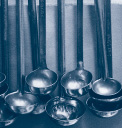
Many cooks insist that authentic bouillabaisse be made only with specific types of fish. To me, it’s the characteristic flavorings—saffron, Pernod, tomatoes—that distinguish bouillabaisse from other seafood stews. My version is in the true spirit of the practical Provençal fishermen who created this now-classic dish as a way to use up odds and ends of leftover or unsold fish. Similarly, I accumulate the trimmings and tail ends of fish at Chanterelle to make this vibrant stew for our staff meal. There’s no need to peel the garlic and onions for the broth, since they’ll be strained out before the fish is added. Once the fish is poaching in the broth, I like to swirl in a splash of good-quality olive oil or a few tablespoons of butter, though butter is absolutely heretical in terms of Provençal cooking. To serve, set a bowl of Aïoli (page 363) on the table along with some toasted slices of French bread. Diners can add a dollop of Aïoli to their stew or spread it on the toast and set it afloat on the stew’s surface. SERVES 8
¼ cup extra-virgin olive oil
2 medium onions, unpeeled, roughly chopped
1 carrot, cut into ¼-inch rounds
4 heads garlic, unpeeled, roughly cut up
1 large fennel bulb, with leafy top, roughly chopped
2 cups dry white wine
1 cup Pernod or other anise-flavored liqueur, or more to taste
8 cups Fish Stock (page 41)
Zest of 2 oranges, cut into strips (no white pith)
2 cups canned whole tomatoes, with liquid, crushed
4 bay leaves
1 teaspoon saffron threads (see box, page 174)
½ teaspoon dried thyme leaves
½ teaspoon dried oregano leaves
½ teaspoon dried rosemary leaves
2 pounds mixed seafood, including mussels and clams in the shell, scallops, firm fish fillets, and cleaned squid (see box, page 249)
Coarse (kosher) salt, to taste (optional)
Aïoli (page 363)
8 to 16 slices French bread, toasted
1. Heat the oil in a medium-size, nonreactive saucepan over medium heat. Add the onions, carrot, garlic, and fennel and sauté, stirring occasionally, until the vegetables are lightly browned, about 8 minutes.
2. Add the wine and 1 cup Pernod and increase the heat to high. Bring to a boil and cook, uncovered, until the liquid is reduced by half, about 10 minutes. Add the fish stock, orange zest, tomatoes, bay leaves, saffron, thyme, oregano, and rosemary. Bring to a boil, then reduce the heat to low and simmer, partially covered, until slightly reduced and the flavors have developed, about 1 hour.
3. While the broth is cooking, prepare the seafood. Scrub and debeard the mussels as described on page 19; scrub the clams. Trim away and discard any muscle from the scallops; cut each fish fillet into 2-inch pieces. Cut the squid bodies into ½-inch rings, and if any tentacles included are large, cut them lengthwise in half.
4. Remove the saucepan from the heat and pour the contents through a strainer into a heatproof container, pressing firmly on the solids in the strainer with the back of a wooden spoon. Discard the solids and return the broth to the saucepan. Season with salt, if necessary, and additional Pernod, if desired, then return to a simmer over low heat. Add the clams to the simmering broth and cook, covered, for 3 minutes, then add the mussels and re-cover. When the clams and mussels are just beginning to open, after 1 or 2 minutes, add the scallops and firmer fish to the pan. Cover and simmer gently until the scallops and fish are almost opaque, about 3 minutes, then add the squid. Continue simmering, covered, until all the mussels and clams have opened and the other seafood is just opaque, about 2 minutes longer.
5. Remove and discard any clams or mussels that haven’t opened. Ladle the stew into large, shallow bowls and serve immediately, with a bowl of aïoli and a basket of toast for the table.
This is a special treat we don’t indulge in often, but always relish. The beer in the batter creates a delightfully light, crisp crust for the fish, which should be served along with heaps of fries and tartar sauce.
If you’re preparing fries with the fish, make them first, then use the same oil the fries were cooked in to fry the fish. SERVES 4
1 bottle (12 ounces) beer
½ cup cold water
2 cups all-purpose flour
½ teaspoon baking powder
½ teaspoon sweet Hungarian paprika
Coarse (kosher) salt and freshly ground black pepper, to taste
Canola or other vegetable oil, for deep-frying
4 flounder fillets (7 to 8 ounces each), cut crosswise in half
Our Favorite Fries (page 327)
Kitchen Cupboard Tartar Sauce (page 367)
1. Place the beer and water in a medium-size bowl and stir to mix. Combine the flour, baking powder, paprika, salt, and pepper in a large bowl, whisking well to mix. Pour the beer mixture over the flour mixture and whisk just to combine.
2. Preheat the oven to its lowest setting. Line a baking sheet with several layers of paper towels.
3. Pour oil to a depth of 3 inches into a deep-fryer or deep, heavy skillet and heat over medium heat. When the temperature reaches 375°F on a deep-fry thermometer, dip a piece of flounder in the beer batter, letting the excess drip back into the bowl, then lower the fish carefully into the hot oil. Fry until golden brown all over, about 3 to 4 minutes, turning once. Fry the fillets 2 at a time to prevent crowding. Transfer the fried flounder to the prepared baking sheet and keep warm in the oven while you fry the rest. Then serve immediately, accompanied by the fries and tartar sauce.
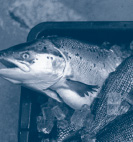
The harmonious flavors of this seafood salad will positively bounce around in your mouth. Be sure to take into account the fact that the dressing is made a day ahead so the flavors have time to mellow. Each type of seafood is poached in Lemongrass Court Bouillon (page 237), then arranged on a baking sheet to cool. Since the seafood will continue to cook until it has cooled, it’s important to slightly undercook it in the bouillon. Don’t stint on the intensely flavorful garnishes that add an all-important final flourish. SERVES 4
½ cup fresh lime juice
⅓ cup water
¼ cup sugar
4½ teaspoons Thai fish sauce (nam pla)
1½ teaspoons good-quality soy sauce, such as Kikkoman
1 teaspoon chili-garlic sauce (sambal oelek)
1 stalk lemongrass, trimmed and very thinly sliced (see box, page 236)
1 large clove garlic, minced
Lemongrass Court Bouillon (recipe follows)
1 monkfish fillet (8 ounces), cut into ½-inch crosswise slices
4 ounces sea scallops
8 ounces medium shrimp, peeled and deveined
4 ounces cleaned squid (see box, page 249), bodies cut into ½-inch rings and tentacles cut lengthwise in half if large
4 ounces lump crabmeat, picked clean
Thinly sliced cucumber, thinly sliced red onion, and fresh cilantro or mint leaves, for garnish
1. Place the lime juice, water, sugar, fish sauce, soy sauce, chili-garlic sauce, lemongrass, and garlic in a small bowl and whisk well to blend. Refrigerate the dressing, covered, for at least 8 hours or overnight.
2. Bring the court bouillon to a boil in a medium-size saucepan over high heat, then reduce the heat to low. Add the monkfish and poach, covered, at a gentle simmer until almost opaque, about 5 minutes. Using a slotted spoon, transfer the fish to a shallow baking pan or rimmed baking sheet to cool. Remember that the seafood will continue cooking as it cools, so do not overcook.
3. Add the scallops to the simmering court bouillon and poach gently, covered, until almost opaque, 2 to 4 minutes, depending on their size. Using the slotted spoon, transfer the scallops to the pan with the monkfish. Add the shrimp to the court bouillon and poach, covered, until they’re curled and just barely pink, about 2 minutes. Transfer the shrimp to the pan. Add the squid to the court bouillon and poach, covered, until almost opaque, 1 to 2 minutes. Transfer them to the pan and let cool for a few minutes. Refrigerate the seafood, uncovered, until thoroughly chilled, about 45 minutes (see Note).
4. When you’re ready to serve, transfer the seafood to a shallow serving bowl. Add the crabmeat. Whisk the dressing to reblend, then strain if desired and pour over the seafood. Toss gently but thoroughly to mix, then taste and adjust the seasoning. Garnish with the cucumber, red onion, and fresh cilantro or mint leaves and serve immediately.
Note: If you won’t be serving right away, cover the seafood with plastic wrap once it’s cool. The seafood may be prepared up to to 24 hours ahead of time.
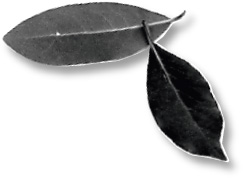
lemongrass
Lemongrass is a staple flavoring in Thai cuisine, often used in soups, salads, and pungent curry pastes. Its flavor is bright and delicately lemony with almost perfumy floral nuances of citrus and a faint ginger undertone. It is sold fresh (best choice, of course), frozen (next best), in dried slices (these will do in a pinch if you soak them in hot water for several hours), or powdered (don’t bother), and is available at Asian markets, some specialty food shops, and the occasional large supermarket. The long, dryish, fibrous stalks have a long bulblike root end, making them look like giant gray-green scallions. If you buy them fresh, you’ll find them trimmed to around 6 to 8 inches above the bulbous root end.
Look for firm, greenish stalks that don’t feel too light when hefted in your hand. Before using, trim off the roots and remove the tough, fibrous outer layer of each stalk. The stalks can be used whole, cut diagonally into chunks, or thinly sliced, depending on the dish. With whole or chunked lemongrass, use the blunt edge of a heavy knife to bruise the stalk and release the essential oils. This is unnecessary for thinly sliced pieces.
To store, set the stalks upright in a container with an inch of cold water or wrap them tightly in plastic wrap and refrigerate for up to 2 weeks. The stalks can also be cut into 2- or 3-inch pieces and frozen for up to a year.
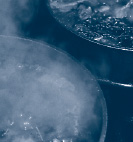
A court bouillon is an aromatic, delicately flavored poaching liquid used to enhance the flavor and color of seafood, meats, or vegetables. This one is perfumed with lemongrass, making it a good choice for poaching seafood that will be served chilled. MAKES ABOUT 8 CUPS
8 cups water
3 stalks lemongrass, trimmed and thinly sliced
Juice of 2 limes
3 tablespoons coarse (kosher) salt
Combine the water, lemongrass, lime juice, and salt in a medium-size, nonreactive saucepan. Bring to a boil over high heat, then reduce the heat to maintain a gentle simmer. Simmer, uncovered, for 30 minutes. Remove the pan from the heat and strain the court bouillon. Use immediately or cool and refrigerate, covered, for up to 1 week, or freeze for up to 3 months.
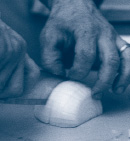
Making these cod cakes is not a spur-of-the-moment proposition: They’re made with salt cod, and salt cod needs to be soaked for 24 hours before using. The flavor and denser texture that salt cod adds, however, make the wait worthwhile. Look for salt cod at Hispanic or Italian markets and some specialty food stores.
Serve the cod cakes with a bowl of Rémoulade (page 366). MAKES SIXTEEN 3-INCH CAKES; SERVES 6 TO 8
2 pounds salt cod
1½ pounds russet potatoes, peeled
¼ cup sour cream
3 cups fresh bread crumbs (see page 279)
4 large eggs, lightly beaten
1 medium onion, coarsely chopped
4 cloves garlic, minced
1 bunch scallions, white and green parts, trimmed and thinly sliced
Juice of 2 lemons
5 tablespoons Worcestershire sauce
1 tablespoon Tabasco sauce
1 tablespoon Old Bay Seasoning
½ cup chopped fresh flat-leaf parsley leaves
Coarse (kosher) salt and freshly ground black pepper, to taste
2 cups all-purpose flour
1 cup cornmeal
Canola or other vegetable oil, for frying
1. Place the salt cod in a large bowl and add cold water to cover. Cover the bowl and soak the cod in the refrigerator for 24 hours, changing the water four times during the soaking.
2. Drain the cod, place it in a large stockpot, cover with fresh cold water, and bring to a boil over high heat. Reduce the heat and simmer the cod until it flakes easily with a fork, 15 minutes. Remove the cod from the pot with a slotted spoon and set aside to cool.
3. While the cod is cooking and cooling, cook the potatoes in a large saucepan of boiling water until tender, 25 to 30 minutes. Drain the potatoes and return them to the pot. Heat them over high heat to dry them thoroughly, 30 seconds. Cool the potatoes, then mash them, preferably through a ricer or food mill. Add the sour cream to the potatoes and stir to mix.
4. Crumble the cod into small flakes in a large bowl using your fingers or a fork. Add the potatoes and bread crumbs and mix until well blended. Mix in the eggs, onion, garlic, scallions, lemon juice, Worcestershire sauce, Tabasco, and Old Bay Seasoning. Stir in the chopped parsley and salt and pepper to taste. Form the cod mixture into cakes about 3 inches around and 1 inch thick.
5. Mix the flour and cornmeal together in a large, shallow bowl. Dip the cod cakes in the flour mixture to coat lightly, shaking off any excess.
6. Pour oil to a depth of ½ inch into a large skillet and heat over medium-high heat. Fry the cakes until crispy brown on both sides, about 3 minutes per side. You’ll have to do this in batches, being sure not to crowd the pan. As they are done, remove the patties to paper towels to drain. Serve immediately.
salt cod
Dried salt-preserved cod is a staple in a number of traditional Mediterranean recipes, the most famous of which is brandade de morue, a specialty of Provence. Sometimes the fish is dried on the bone, but more commonly in the United States you’ll find boneless and skinless fillets.
Look in ethnic markets for fish fillets that are white (gray is a sign of age) and of uniform thickness. In Italian salt cod is called baccalà, in Spanish bacalao, and in Portuguese bacalhau.
Before salt cod is used in a recipe, it must first be soaked to soften it and to remove the saltiness. To do this, cut the cod into a few largish pieces, arrange in a large, nonreactive glass or ceramic bowl, and cover completely with cold water. Place the bowl in the refrigerator and let the cod soak for a minimum of 24 hours, changing the water at least four or five times. The cod is ready to use when the water no longer tastes salty. Rinse under cold running water, drain well in a colander or sieve, and pat dry with paper towels before using. Check for bones before proceeding with a recipe.
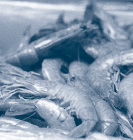
The dark and delicious sauce in this recipe is a snap to prepare if you keep a few basic Asian ingredients, such as Thai fish sauce and Chinese fermented black beans, in your pantry. And don’t reserve the sauce exclusively for shrimp. It matches up well with sautéed or steamed fish fillets; bass, grouper, cod, scrod, and snapper all take to it. For a luxurious treat, briefly sauté chunks of cooked lobster (figure on ¼ pound per person) in very hot oil, then toss with the sauce. SERVES 6 TO 8
½ cup canola or other vegetable oil
2½ pounds shelled and deveined medium shrimp
2 cloves garlic, minced
2 tablespoons grated fresh ginger
2 bunches scallions, white and green parts, trimmed, 1 bunch finely chopped, 1 bunch cut into ½-inch pieces
¼ teaspoon hot red pepper flakes
2 tablespoons dry sherry
2 cups Chicken Stock (page 39) or canned low-sodium chicken broth
1½ tablespoons good-quality soy sauce, such as Kikkoman
1 tablespoon Thai fish sauce (nam pla)
¼ cup Chinese fermented black beans (do not rinse)
1 red bell pepper, stemmed, seeded, and cut into ⅛-inch-wide strips
1 small onion, cut lengthwise (stem to root) into ⅛-inch strips
1 tablespoon rice vinegar
Pinch of sugar
1½ teaspoons cornstarch
2 tablespoons cold water
1. Heat a large skillet or wok over high heat. When it’s very hot (a drop of water sizzles rapidly on contact), add enough of the oil to coat the bottom of the pan (about 2 tablespoons). Stir-fry the shrimp in batches until just cooked through, about 3 minutes per batch. As the shrimp are done, scoop them out of the skillet and set aside.
2. Wipe out the pan and return it to high heat. Add another 2 tablespoons of the oil and, when it’s hot, add the garlic, ginger, chopped scallions, and pepper flakes and sauté until aromatic but not browned, about 1 minute. Add the sherry and boil for 30 seconds. Add the chicken stock, soy sauce, fish sauce, and black beans. Bring to a boil, then add the bell pepper, onion, vinegar, and sugar. Cook at a rapid boil for 3 minutes.
3. Whisk the cornstarch with the water to blend. When smooth, whisk it into the sauce in the skillet. Continue whisking until the sauce returns to a boil and thickens slightly, 2 minutes.
4. Remove the skillet from the heat, stir in the scallion pieces and the shrimp, and return the skillet to the heat. Cook until just heated through and serve.
thailand’s soy sauce
Fish sauce, a universal flavoring in Southeast Asian cooking, is called nuoc mam in Vietnam, tuk trey in Cambodia, and nam pla in Thailand. At Chanterelle our straightforward staff simply calls it “rotten fish sauce.” It’s made from the liquid exuded from salted anchovies that have been left to ferment for several months. Enormously concentrated in flavor, this translucent, pale brown sauce smells awful, but don’t let that stop you. The flavor becomes less powerful, even somewhat delicate, when combined with other ingredients. Nam pla is used in small amounts to round out the taste of Thai marinades, soups, stir-fries, and dipping sauces. It’s available in Asian markets and specialty food stores. In my experience the best nam pla comes in glass bottles. These cost slightly more but are less salty and stay fresher longer than those in plastic. Good brands to look for include the Thai Fishsauce Company’s Squid brand (my favorite), Dek, Tiparos, Ruang Tong, and Viêt Huong’s Three Crabs brand. Tightly capped, nam pla can be stored indefinitely in a cool, dark cupboard.
cleaning soft-shell crabs
It’s best to clean soft-shell crabs as close to cooking time as possible. To prepare a live crab, place it top-side up on your work surface. Using kitchen shears, cut off the crab’s face right behind the eyes; this will kill it. Right behind where the mouth was, you will find a little bubblelike sac; pull it out and discard it.
Turn the crab upside down. You will see a tail flap, called the apron; cut it off with the shears. One at a time, fold back each pointed side of the top shell so the gills are exposed; remove and discard the gills.
Continue as directed for all your remaining crabs. Once all have been cleaned, they’re ready to be cooked according to your recipe. If you aren’t continuing with the recipe immediately, wrap the crabs in plastic wrap or waxed paper and refrigerate until cooking time.
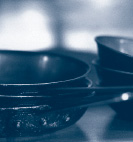
Soft-shell crabs are blue crabs that have molted their shells and are on the verge of growing new ones. The season for this East Coast specialty is from May through August, and during that time I always put them on the menu at Chanterelle. They are a bit pricey for the usual staff meal, but we’ve found that we need to have a soft-shell crab dinner at least once a year as a well-deserved treat. Aside from enjoying them deep-fried and served on a bun with hot sauce (the best way, no question), we also like them sautéed and accompanied by this refined, tart, and lemony sorrel sauce. Be sure the crabs are alive when you buy them. Cleaning them is a simple-enough task but if you’re the least bit squeamish have the fishmonger clean them for you. Once this is done, they must be eaten within 24 hours. A word of caution: When sautéing, use a splatter guard to prevent the sputtering crabs from spitting hot oil at you, or be prepared to duck! SERVES 4
8 live soft-shell crabs
¼ cup white wine vinegar
¼ cup dry white wine
2 shallots, minced
3 tablespoons heavy (or whipping) cream
4 ounces sorrel, stemmed, rinsed, and dried
1 cup (2 sticks) unsalted butter, cut into small pieces, chilled
Coarse (kosher) salt and freshly ground black pepper, to taste
Fresh lemon juice, to taste
1 cup all-purpose flour, or more if needed, for coating
Canola or other vegetable oil, for frying
1. Have the crabs cleaned by your fishmonger, or clean them yourself (see box, page 242). Rinse under cold running water and pat dry with paper towels.
2. Combine the vinegar, wine, and shallots in a small, heavy, nonreactive saucepan and bring to a boil over high heat. Cook, stirring frequently, until the liquid is reduced to about 2 tablespoons, about 5 minutes. Watch carefully to keep the reduction from burning.
3. Add the cream and sorrel to the pan and cook, stirring frequently, until the sorrel is reduced almost to a purée and the cream has thickened, about 2 minutes. (It will have an almost mushlike consistency.) Reduce the heat to low and whisk in the butter, bit by bit, adding the next bit as the previous one has been emulsified into the sauce. Keep checking the temperature of the sauce. It should stay very warm, almost but not quite hot; nor should it get too cool. To accomplish this, move the pan on and off the heat, as necessary. When all the butter has been incorporated, season with salt, pepper, and lemon juice, then set aside, covered, to keep warm while you cook the crabs.
4. Preheat the oven to its lowest setting. Line a baking sheet with several layers of paper towels.
5. Spread about 1 cup of the flour on a plate. Dip each crab in the flour to coat on both sides, shaking off any excess, and place on a platter or baking sheet while you heat the oil.
6. Pour oil to a depth of ¼ inch into a large, heavy skillet and heat over high heat. It should be hot enough so a sprinkle of flour sizzles on contact. Add half the crabs, arranging them with tongs so they’re in their natural position. Sprinkle lightly with salt, place a splatter guard (if you have one) over the skillet, and reduce the heat to medium high. Sauté the crabs until they’re a golden reddish brown, about 2 minutes per side. Transfer the crabs to the prepared baking sheet and keep warm in the oven while you sauté the remaining crabs.
7. Ladle about ¼ cup sauce on each of four serving plates and arrange 2 crabs over each portion of sauce. Serve immediately.
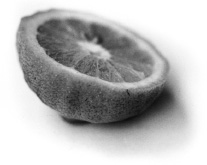
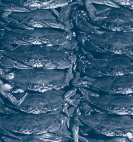
The seasonings in these crab cakes give them a little kick that enhances the natural sweetness of the crabmeat. This is a handy double-duty recipe from which you can make 3-inch crab cake patties to serve as a main course or bite-size ones suitable as an hors d’oeuvre (this recipe would make about 50 tiny cakes). The patties can be frozen, then thawed before frying. Serve the crab cakes simply, with just lemon wedges, a dollop of Rémoulade (page 366), Kitchen Cupboard Tartar Sauce (page 367) or Curried Mayonnaise (page 361), and some of Our Favorite Fries (page 327). MAKES FOUR 3-INCH CAKES; SERVES 4
1 pound lump crabmeat
1 large egg
½ cup fine dry bread crumbs (see box, page 279)
¼ cup good-quality store-bought mayonnaise, such as Hellmann’s
¼ cup thinly sliced scallions, white and green parts
1 heaping tablespoon Dijon mustard
1 teaspoon sweet Hungarian paprika
1½ teaspoons Tabasco sauce
1 clove garlic, minced
Fresh lemon juice, to taste
Coarse (kosher) salt and freshly ground black pepper, to taste
1 cup all-purpose flour, or more if needed, for coating
2 to 3 tablespoons canola or other vegetable oil
1. Pick over the crabmeat to remove any cartilage or stray bits of shell, but try not to break it up too much. Combine the crab in a bowl with the egg, bread crumbs, mayonnaise, scallions, mustard, paprika, Tabasco, garlic, lemon juice, salt, and pepper. Using your hands or a wooden spoon, mix thoroughly, but again, try not to break up the lumps of crab.
2. Form the mixture into four 3-inch patties. Spread 1 cup flour on a plate and dip the patties, one at a time, in it to coat on both sides, shaking off any excess.
3. Heat 2 tablespoons of the oil in a large, heavy skillet over medium heat; it should be hot enough so a sprinkle of flour sizzles on contact. Add the crab cakes and sauté until golden brown on both sides and heated through, about 3 minutes per side. If the crab cakes seem to be sticking to the pan, add more oil.
4. Using a slotted spatula, transfer the crab cakes to a platter or individual plates and serve immediately.

This less traditional, somewhat more exotic crab cake recipe incorporates plenty of Asian seasonings. As with the Deviled Crab Cakes (page 245), these too can be frozen, then thawed before frying. Serve the crab cakes with wedges of lime or Curried Mayonnaise (page 361); Cucumber Salad with Red Onion and Chinese Sausage (page 314) makes an unusual accompaniment.
These crab cakes also work well as an hors d’oeuvre; the recipe yields about 50 tiny cakes. MAKES FOUR 3-INCH CAKES; SERVES 4
1 pound lump crabmeat
2 large eggs
¾ cup fine dry bread crumbs (see box, page 279)
½ cup thinly sliced scallions, white and green parts
2 tablespoons good-quality soy sauce, such as Kikkoman
1 tablespoon Thai fish sauce (nam pla)
2 teaspoons Chinese chili sauce
1½ teaspoons grated fresh ginger
1 large clove garlic, minced
Fresh lime juice, to taste
Coarse (kosher) salt and freshly ground black pepper, to taste
1 cup all-purpose flour, or more if needed, for coating
2 to 3 tablespoons canola or other vegetable oil
1. Pick over the crabmeat to remove any cartilage or stray bits of shell, but try not to break it up too much. Combine the crab in a bowl with the eggs, bread crumbs, scallions, soy sauce, fish sauce, chili sauce, ginger, garlic, lime juice, salt, and pepper. Using your hands or a wooden spoon, mix thoroughly, but again, try not to break up the lumps of crab.
2. Form the mixture into four 3-inch patties. Spread 1 cup flour on a plate and dip the patties, one at a time, in it to coat on both sides, shaking off any excess.
3. Heat 2 tablespoons of the oil in a large, heavy skillet over medium heat; it should be hot enough so a sprinkle of flour sizzles on contact. Add the crab cakes and sauté until golden brown on both sides and heated through, about 3 minutes per side. If the crab cakes seem to be sticking to the pan, add more oil.
4. Using a slotted spatula, transfer the crab cakes to a platter or individual plates and serve immediately.

This versatile stew is an opportunity to enjoy squid at its best, slowly cooked to perfection until it’s soft and flavorful. The key to success here is understanding that squid must be either cooked very quickly, for only 2 or 3 minutes, or simmered very slowly for at least 45 minutes. There is no in-between. After the first few minutes of exposure to heat squid goes from supple to tough, chewy, and rubbery and does not relax and regain its suppleness until it has cooked for at least half an hour.
As a variation, I sometimes substitute ½ cup Pernod for half the dry white wine and add ½ cup pitted olives along with the vegetables. You might also enjoy it using a combination of scallops and squid. Serve the stew with plain rice or orzo. SERVES 4 TO 6
¼ cup extra-virgin olive oil
2 medium onions, coarsely chopped
4 large cloves garlic, coarsely chopped or thinly sliced
¼ teaspoon saffron threads (see box, page 174)
1 cup dry white wine
2 cups canned whole tomatoes, drained, seeded, and coarsely chopped (about 1 cup)
2 cups Fish Stock (page 41)
½ teaspoon dried thyme leaves
½ teaspoon dried oregano leaves
½ teaspoon hot red pepper flakes, or to taste
3 pounds cleaned fresh squid (see box), bodies cut into ¼-inch rings and tentacles cut lengthwise in half if large (see Note)
½ cup frozen peas (no need to thaw)
1 medium zucchini, sliced lengthwise in half, then cut crosswise into ¼-inch slices
2 medium carrots, peeled and cut into ¼-inch rounds
2 tablespoons unsalted butter
Coarse (kosher) salt, to taste
Fresh lemon juice, to taste
1. Heat the oil in a medium-size saucepan over medium heat. Add the onions and garlic and cook, stirring, until translucent but not browned, about 5 minutes. Add the saffron and cook, stirring, for 3 minutes more. Add the wine, increase the heat to high, and bring to a boil. Cook, uncovered, until the wine is reduced by half, about 5 minutes.
2. Add the tomatoes, fish stock, thyme, oregano, and pepper flakes and bring to a boil. Add the squid, then reduce the heat to low and simmer, uncovered, for 20 minutes. The squid will release liquid, making the mixture nice and saucy. Add the peas, zucchini, and carrots and simmer until the squid is quite tender, about 10 minutes more.
3. Remove the pan from the heat and stir in the butter. Season with salt and lemon juice and serve immediately.
Note: If fresh squid is not available, use 3 pounds thawed frozen squid that has already been cleaned, but not cut into rings.
how to clean squid
Pull the head and attached tentacles from the tubelike body of the squid. As you do this, most of the innards will automatically disengage from the inside of the body and come away with the head and tentacles. With a sharp knife, cut off the tentacles just in front of the eyes. Discard the head and innards; reserve the tentacles for use in your recipe, if called for.
If you’ll be using the tentacles, fold them back and, using your thumb and forefinger, gently squeeze out the beak (a small piece of cartilage).
To clean out the body, grasp the exposed end of the long, thin, transparent quill-like piece of cartilage, pull it out, and discard. Peel off as much of the skin from the body as possible; most, though not all, will come off. (Doing this under cold running water will help.) Thoroughly rinse the body, inside and out, under cold running water, pulling out and discarding any matter that has remained inside.
Leave the body whole or cut it into rings, depending on the recipe.
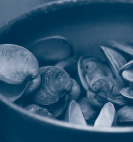
The combination of briny clams and salty fermented black beans is a classic one in Cantonese cooking. Try to use tiny sweet Manila clams or cockles; if these are unavailable, substitute the smallest littleneck clams you can find. Some recipes call for rinsing or chopping the black beans, but I leave them whole, balancing their pronounced, appealing saltiness with other seasonings. In fact, it is this salinity, along with the beans’ rustically strong, almost musty flavor, that makes this dish so special. I like the sauce to have a noticeably spicy edge to it, so I use plenty of hot red pepper flakes, but you may prefer to use less for a milder flavor. SERVES 4
3 pounds small clams in the shell, preferably Manila or cockles
1¼ cup Chicken Stock (page 39), canned low-sodium chicken broth, or water
1 tablespoon cornstarch
1 tablespoon oyster sauce
1 tablespoon good-quality soy sauce, such as Kikkoman
2 teaspoons sugar
2 tablespoons canola or other vegetable oil
2 large cloves garlic, minced
1 tablespoon grated fresh ginger
2 bunches scallions, trimmed, white parts finely chopped and green parts cut separately into ½-inch lengths
3 tablespoons Chinese fermented black beans
¼ to ½ teaspoon hot red pepper flakes, to taste
2 teaspoons dry sherry
1 teaspoon Asian sesame oil
1. Using a stiff brush, scrub the clams under cold running water. Rinse them well in a colander and set aside.
2. Place the chicken stock, cornstarch, oyster sauce, soy sauce, and sugar in a bowl and stir until the cornstarch and sugar are dissolved. Set aside.
3. Set a wok or large skillet over high heat and add the oil, swirling it around to coat as much surface as possible. When a drop of water sizzles rapidly on contact with the oil, add the garlic, ginger, and scallion whites and stir-fry until aromatic but not browned, about 1 minute.
4. Add the black beans and pepper flakes and stir until aromatic, about 30 seconds. Add the sherry and cook, stirring, for 10 seconds. Add the clams, then the chicken stock mixture, giving the mixture a stir before pouring it in. Give the clams a good stir, then cover and cook, shaking the wok occasionally, until most of the clams are opened, about 5 minutes.
5. Add the scallion greens and sesame oil and cook until all the clams have opened, the sauce is lightly thickened, and everything looks beautiful, 1 minute more.
6. Turn the clams and sauce out onto a platter or into a shallow serving bowl, discarding any that didn’t open. Serve immediately.